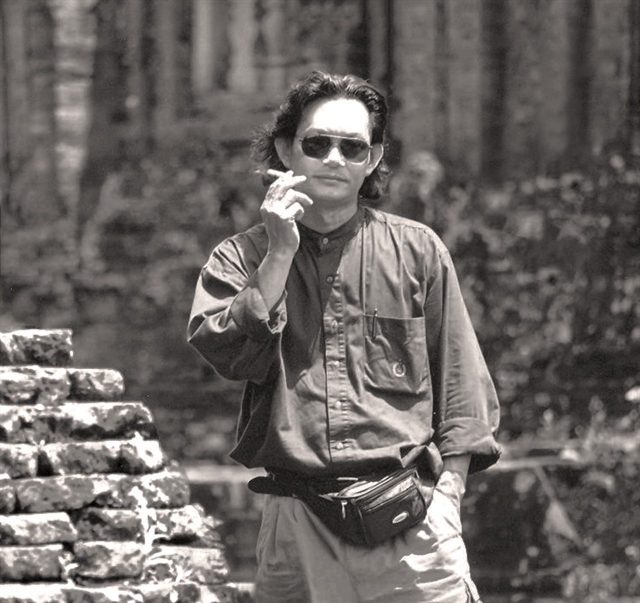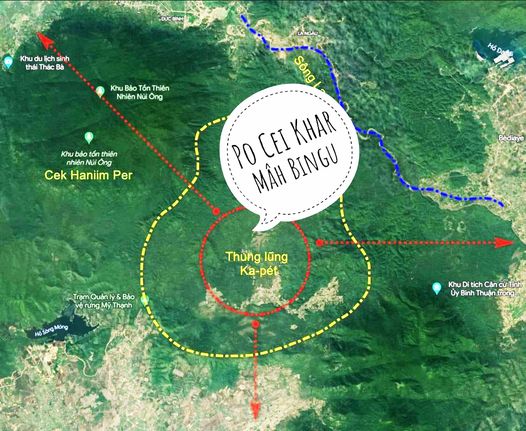 Life & Style
Life & Style

 |
| Writer Vĩnh Quyền at a Cham sanctuary. Photo Vũ Mạnh Cường |
By Vĩnh Quyền*
Throughout my writing career, I have conducted numerous field trips to Cham villages and sanctuaries in Việt Nam. Although I have not fully grasped the intricacies of their culture, I have observed a crucial aspect: the Cham people's unwavering attachment to their sacred land, where they constructed structures to honour their gods and saints. Despite the destruction of many Cham relics due to natural disasters and wars, the Cham people have not forgotten them. They remain vivid in their minds, and legends and poetry preserve the light of the fading sun alive across generations in families and communities. Then, when conditions permitted, they returned to these painful ruins and restored them.
Since 2019, investors and state managers have been evaluating the possibility of clearing almost 619 hectares of Kapet Forest in Bình Thuận Province, including 137.95 hectares of special-use forest, to construct a new irrigation lake. However, they have failed to address the potential harm to the local cultural environment. Specifically, I would like to bring attention to the Raglai ethnic community, whose livelihoods are intertwined with the Kapet Forest. The area also contains Cham relics that have been present for over 300 years, which will soon be submerged by the artificial lake.
According to information from the press conference on September 7, 2023 by Bình Thuận Province, the National Assembly approved the Kapet Reservoir project in 2019, which has a capacity exceeding 51 million cubic meters and a total investment of VNĐ874 billion (approximately US$36.4 million). The project's primary goals are to supply water for agricultural purposes in South Hàm Thuận District, support production activities in the Hàm Kiệm 2 Industrial Zone, and meet the daily water needs of South Hàm Thuận District and Phan Thiết City. Additionally, the project will serve flood prevention and control, environmental enhancement, and water regulation for downstream areas of South Hàm Thuận District and Bình Thuận Province. The reservoir will increase water availability during the dry season, benefiting Phan Thiết City and contributing to the development of tourism and service sectors in the province.
 |
| Po Cei Khar Mâh Bingu Temple in the Kapet Forest. |
However, the project plans to clear 619 hectares of natural forest in Mỹ Thạnh Commune, South Hàm Thuận District. According to the Law on Forestry, Bình Thuận Province must replant around 1,844 hectares of forest in different locations to compensate for the lost forest area. The law stipulates that the replacement forest must be three times the size of the natural forest that has been converted for other purposes, with an estimated total cost of planting replacement forests at approximately VNĐ177 billion ($7.3 million). The project underwent a survey, inventory and assessment of the forest's status.
On June 28, 2023, the Ministry of Natural Resources and Environment (MONRE) granted a licence to the project for exploitation, while local authorities submitted the environmental impact assessment to MONRE in August this year.
The purpose of constructing a new irrigation lake, the 50th in Bình Thuận Province, is clear: to alleviate the shortage of water for daily life, agricultural production and other industries.
However, there are two opposing views regarding the project before and after the press conference. On one side, supporters argue that it is necessary to improve the livelihoods. On the other side, opponents say that the project's cost of losing forests for water is too high, as both resources are vital for human life, and there are viable alternatives to have water without losing forests. They criticised South Hàm Thuận District for having a water reservoir that has been abandoned for many years. Some scientists support this view. While investors and licencing agencies try to convince that Kapet is mostly a poor forest, they have just discovered in Kapet Forest two rare tree species and 57 animal species listed in the Việt Nam Red Book (2007), CITES, Decree 32 of the Government.
I belong to the second group mentioned above, but my reason for being here has already been explained. The Kapet Valley is not only a natural habitat for various animals, but it is also a long-standing home for several different native groups, including the Cru, Raglai, K'ho, and Cham people. This valley acts as a protective green roof that preserves the ancient culture of Cham, spanning more than 10 hectares. I find the temples dedicated to the two founders, Po Haniim Pôr and Po Cei Khar Mâh Bingu, fascinating to discuss. Po Cei Khar Mâh Bingu was even bestowed with a prestigious title twice by the kings of the Nguyễn Dynasty.
Over 300 years, and for every seven years, the Cham-Raglai Bình Thuận community has organised a pilgrimage to the Kapet relics and performed a bone bathing ceremony for their saint, Po Cei Khar Mâh Bingu. The Cham and Raglai people have safeguarded this forest as their sacred space, allowing it to retain its characteristics as a primitive forest, which serves as evidence of the birth of Bình Thuận Province over 300 years ago.
But now, the Cham-Raglai people have not had their say during the 15-day public opinion period that recently ended, concerning the environmental impact of the decision to destroy Kapet Forest for a water reservoir.
If nothing changes before the construction start order is issued, everything will be submerged beneath the lake, lost forever.
Life will go on, but it will not be the same.
The water source will benefit 7,762 hectares of agricultural land in South Hàm Thuận District, providing happiness to local farmers. New afforests will be planted according to the commitment, even though everyone knows in advance that they can never replace the primary forests that were exploited, resulting in an immeasurable loss.
Similarly, the Cham-Raglai people will move their Po Cei Khar Mâh Bingu temple to a new location to continue worshiping, but the ancient holy land will not be forgotten. It will live on in new Cham stories and laments.
More broadly, everyone who is interested in the country's history will not forget our behavior towards nature today. We have decided to submerge historical sites into an artificial lake bed. That loss cannot be compensated for and cannot be forgotten.
____
* Vĩnh Quyền, a member of the Vietnam Writers Association and former Head of the Lao Dong Newspaper Representative Office in Central and Central Highlands, Vietnam, has authored 20 books in Vietnamese and three novels in English: Debris of Debris, Inside Infinity, and Heart for Forests.
The Vietnam Writers Association awarded him two novel awards: Debris of Debris (2016) and Inside Infinity (2019). Recently, in August of this year, his novel Inside Infinity was recognized with the Southeast Asian Writers Award.